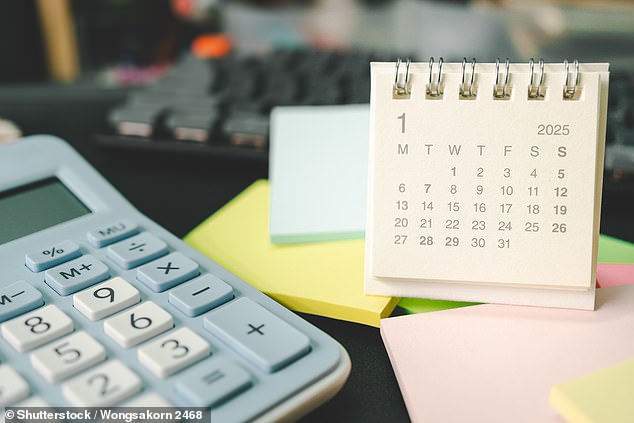- We also provide a five-step guide to getting to grips with your pension
Updated:
Nearly half of adults believe they are ‘pension planners’ who are on top of contributions and what they need for a decent retirement, new research reveals.
Some 44 per cent of people feel confident enough to describe themselves this way, but 22 per cent admit to burying their heads in the sand and being unsure where to begin.
The rest fall in the middle and declare themselves neither a ‘planner’ nor a ‘procrastinator’ when it comes to sorting out their finances to be prepared for retirement.
Men are more likely to think of themselves as a ‘planner’, with 54 per cent identifying with this role compared with 35 per cent of women, according to Aviva which carried out the research.
‘While this might suggest a confidence or engagement gap, it’s also possible that men are more likely to say they are financially knowledgeable, or that women are simply more candid about their uncertainties,’ says the pension firm.

Aviva also says income is a factor in shaping people’s habits, with 33 per cent of people earning £35,000 or less a year saying they are pension planners.
But that rises to 66 per cent of those earning between £75,000 and £100,000 and reaches as high as 80 per cent at the top end of the income scale.
Less prevalent confidence among lower earners could reflect affordability concerns or a sense of disengagement, while higher earners feel more able to take control of their finances, suggests Aviva.
Meanwhile, among 45 to 54-year-olds – a key age when preparing for retirement – 32 per cent called themselves ‘planners’, 29 per cent said they were ‘procrastinators’ and the rest said neither.
Aviva surveyed more than 2,000 adults, of whom around 1,370 were dating, living together, married or in a civil partnership.
In this group, 22 per cent said their partner was a planner, 12 per cent called them more of a procrastinator, 28 per cent said they were neither, 26 per cent said both of them were clued up on pensions and 13 per cent said neither were on top of matters.
The results suggest a gap in communication and self-awareness in couples, which means there is room for more collaborative conversations, according to Aviva.
How to sort out your pension: A five step guide
1) Add up what you have saved so far
If you are worried about whether you will have saved enough, investigate your existing pensions . Broadly speaking, you need to ask work schemes the following questions.
– The current fund value.
– The current transfer value – because there might be a penalty to move.
– Whether the pension is in a final salary or defined contribution scheme. Defined contribution pensions take contributions from both employer and employee and invest them to provide a pot of money at retirement.
Unless you work in the public sector, they have now mostly replaced more generous gold-plated defined benefit – career average or final salary – pensions, which provide a guaranteed income after retirement until you die.
Defined contribution pensions are stingier and savers bear the investment risk, rather than employers.
– If there are any guarantees – for instance, a guaranteed annuity rate – and if you would lose them if you moved the fund.
– The pension projection at retirement age. You can use a pension calculator to see if you will have enough – check ours below.
Pension calculator: When can you afford to retire?
When can you afford to retire and how much do you need to get the lifestyle you want?
This is Money’s pension calculator, powered by Jarvis, uses benchmark PLSA Retirement Living Standards amounts to help you work out what your retirement could look like – and what you need to save.
2) Check what you will get in state pension
You should add the forecast figures to what you anticipate getting in state pension, which is currently £230.25 a week or nearly £12,000 a year if you qualify for the full rate.
Get a state pension forecast here.
3) Work out whether this will be enough
You can use a pension industry-devised standard for a minimum, moderate and comfortable retirement to see how close you will get.
This year’s figures are £21,600, £43,900 or £60,600 a year respectively for a couple, with the first one doable if you have two full state pensions coming in.
However, they do not include income tax, housing costs if you are still paying a mortgage or rent, and potentially care costs in later life.
Others in the finance industry suggest a different approach which is to think about what you earn now and what proportion of that income – the target replacement rate – you want to aim for in retirement.
You need to bear in mind that you will no longer have work-related costs such as travel, clothes and lunches, but you are likely to spend more on hobbies, socialising and holidays.
4) Think about tidying up your pensions
Savers often collect a number of pension pots during their working lives as they move jobs but many never bother combining them. Doing this can save on paperwork and costs.
But merging pensions is not always advisable because you can risk losing valuable benefits attached to employer schemes.
Read our guide to merging pensions to ensure you won’t be penalised.
4) Find any lost pots
If you have lost track of old pots, the Government’s free pension tracing service is here.
Take care if you do an online search for the Pension Tracing Service as many companies using similar names will pop up in the results.
These will also offer to look for your pension, but try to charge or flog you other services, and could be fraudulent.
Here’s our guide to finding lost pensions.
SIPPS: INVEST TO BUILD YOUR PENSION
Affiliate links: If you take out a product This is Money may earn a commission. These deals are chosen by our editorial team, as we think they are worth highlighting. This does not affect our editorial independence.








